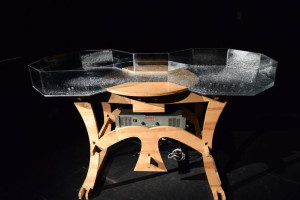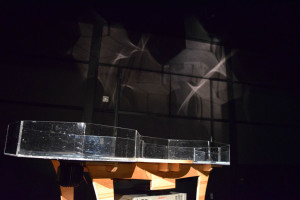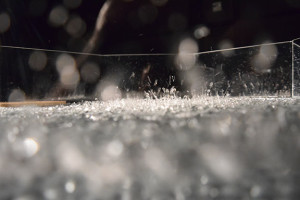 The Cymatic Water Tank Visualizer is OpenLab’s latest investigation into the physicality of sound. Artists David Harris, Sean Pace, and Zach Corse worked with Professor Parker to construct a mixing table not unlike a DJ’s that is every bit an experiment as it is an art installation. Two mirrored octagons connected by a thin bridge sit atop an elegantly crafted wooden table designed and built by the artists. Plexiglass surrounds the mirrored octagons, forming a large tank in which sits an inch of silvery-looking water. Altogether the installation presents a pretty, serene spectacle. That is, until the sound turns on. Hidden beneath the mirrored tank hangs two buttkicker transducers that vibrate the tank. The water translates vibration patterns from the mirrored plexiglass, rendering interesting resonance patterns visible to the naked eye. Depending on the transducer frequencies driving the plexiglass, different visual patterns emerge accompanied by the hums and bangs of the tank moving in its housing. These sounds and sights vary significantly in intensity. At times the tank throbs with the pulse of a motorcycle’s engine as water froths as high as six inches. In another mode, the tank hums quietly and snakelike patterns stretch across its glassy surface. After studying these phenomena, the artists designed two modes of operation for viewers to engage with.
The Cymatic Water Tank Visualizer is OpenLab’s latest investigation into the physicality of sound. Artists David Harris, Sean Pace, and Zach Corse worked with Professor Parker to construct a mixing table not unlike a DJ’s that is every bit an experiment as it is an art installation. Two mirrored octagons connected by a thin bridge sit atop an elegantly crafted wooden table designed and built by the artists. Plexiglass surrounds the mirrored octagons, forming a large tank in which sits an inch of silvery-looking water. Altogether the installation presents a pretty, serene spectacle. That is, until the sound turns on. Hidden beneath the mirrored tank hangs two buttkicker transducers that vibrate the tank. The water translates vibration patterns from the mirrored plexiglass, rendering interesting resonance patterns visible to the naked eye. Depending on the transducer frequencies driving the plexiglass, different visual patterns emerge accompanied by the hums and bangs of the tank moving in its housing. These sounds and sights vary significantly in intensity. At times the tank throbs with the pulse of a motorcycle’s engine as water froths as high as six inches. In another mode, the tank hums quietly and snakelike patterns stretch across its glassy surface. After studying these phenomena, the artists designed two modes of operation for viewers to engage with.
 The first is what they call the tank’s “mixing mode” — so named for the tank’s DJ mixing table-like appearance. Viewers can manipulate a MIDI board situated between the two mirrored octagons that controls the frequencies sent to the transducers. Each slider controls the amplitude of a specific resonant frequency in the tank. If two or more sliders are used, code written in MAX/MSP sums the frequencies and sends the new signal to the transducers. In effect, the mixing table in this mode is a visual Fourier synthesizing device. Not only do these summed frequencies generate interesting visual resonance patterns, but they’re audible as well. The transducers shake the tank sufficiently violently to produce drum-like sounds. With each new frequency added to the mixture, the rhythms of the drum pattern increase in complexity.
The first is what they call the tank’s “mixing mode” — so named for the tank’s DJ mixing table-like appearance. Viewers can manipulate a MIDI board situated between the two mirrored octagons that controls the frequencies sent to the transducers. Each slider controls the amplitude of a specific resonant frequency in the tank. If two or more sliders are used, code written in MAX/MSP sums the frequencies and sends the new signal to the transducers. In effect, the mixing table in this mode is a visual Fourier synthesizing device. Not only do these summed frequencies generate interesting visual resonance patterns, but they’re audible as well. The transducers shake the tank sufficiently violently to produce drum-like sounds. With each new frequency added to the mixture, the rhythms of the drum pattern increase in complexity.
 The second mode of operation is the tank’s “playback mode.” Most recently, the group wrote a MAX/MSP program for this mode to play earthquake seismograph data that was converted into sound data. Drawing on a live feed from the US Geological Survey, this program monitors earthquake activity around the world and the tank responds to any earthquakes that occur with a vibration proportionate to the size of the quake. It activates approximately 5-6 times an hour based on the random distribution of global earthquakes. This past October, the group used this mode to play a re-creation of the 1906 San Francisco earthquake seismograph data at Science Hack Day in San Francisco, winning them the award for best data visualization.
The second mode of operation is the tank’s “playback mode.” Most recently, the group wrote a MAX/MSP program for this mode to play earthquake seismograph data that was converted into sound data. Drawing on a live feed from the US Geological Survey, this program monitors earthquake activity around the world and the tank responds to any earthquakes that occur with a vibration proportionate to the size of the quake. It activates approximately 5-6 times an hour based on the random distribution of global earthquakes. This past October, the group used this mode to play a re-creation of the 1906 San Francisco earthquake seismograph data at Science Hack Day in San Francisco, winning them the award for best data visualization.
See the Cymatic Water Tank in action.
 The Cymatic Water Tank Visualizer has travelled to a number of shows in the Bay Area. In September, visitors attending the California Academy of the Sciences’ Adult Night got a chance to interact with its DJ-mixing mode. This past October, the group showed at the LAST (Life Art Science Technology) show at Stanford University. If you’d like to build a Cymatic Water Tank Visualizer of your own, you can do so if you follow the instructables we wrote for the project.
The Cymatic Water Tank Visualizer has travelled to a number of shows in the Bay Area. In September, visitors attending the California Academy of the Sciences’ Adult Night got a chance to interact with its DJ-mixing mode. This past October, the group showed at the LAST (Life Art Science Technology) show at Stanford University. If you’d like to build a Cymatic Water Tank Visualizer of your own, you can do so if you follow the instructables we wrote for the project.
